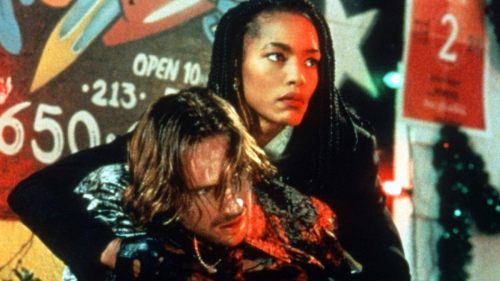Support Female Filmmakers (As Long As They “Behave”)
The most disturbing moment in Don Siegel’s hot house mood piece The Beguiled (’71) comes when Clint Eastwood’s wounded Union soldier, drunk on wine and missing a leg his courteous keepers took after knocking him down a Freudian flight of stairs, threatens to rape Hallie (Mae Mercer), the house slave at a Southern charm school Miss Martha (Geraldine Page) runs while the Civil War rages on in the distance. Sneering that he might take her into the cellar and “change his luck” (an antiquated racist term white men used to describe sleeping with black women), Hallie tells the intoxicated barbarian that he’d have to kill her first. It’s an arresting bit of subversion, where we witness the seething racism that lived in the hearts of certain soldiers who fought to keep the United States whole, proving Hallie’s earlier assertion that Yankees didn’t give a damn about abolishing slavery. This war was about honor among slighted countrymen; nothing more.
When Sofia Coppola decided to remake The Beguiled, it was simple to see what attracted her to the material. Here’s a group of women, of all ages and stages of maturity, isolated in a microcosm they had to maintain themselves. Add in a little Marie Antoinette (’06) opulence (influenced by paintings and photos of Antebellum socialites), and the humidly Gothic setting is perfectly suited to her style. Like Coppola’s feature debut, The Virgin Suicides (’99), which focused on enigmatic Detroit sisters who decide to kill themselves, or Lost In Translation (’03), which found a lonely young woman exploring a country not her own, it’s about the female experience budding amidst hostile or uncertain terrains. Even The Bling Ring (’13), where the majority of the thieving protagonists are women, showcases an alien landscape and the media frenzy that attempts to decode its female anti-heroes. Adapted both as a redux of Siegel’s personal favorite of his films, and a second adaptation of Thomas Cullinan’s ’66 novel* Coppola reportedly wrote her Beguiled during the height of the Trump/Clinton campaigns, and was fascinated by the power dynamics it displayed, and how both women and men could be (mis)perceived whilst attempting to assert themselves.
In other words, Sofia Coppola set out to make a Sofia Coppola picture. So, when she excised the character of Hallie entirely (thus altering the politics of both the original film and text), it could be argued that it was done in the name of strengthening her thematic focus on the psychosexual tug of war occurring between her version of John McBurney (Colin Farrell), and the school of women he unwittingly invades, divides, and gets conquered by. The problematic nature of such an omission is apparent, but as Ira Madison points out:
“If anything, Coppola is guiltier of self-preservation than cultural erasure.
Social media likes to engage in call-out culture, demanding that filmmakers be inclusive in their projects—which is great when it comes to bullshit like Ghost in the Shell, but demanding that a white woman who has never written a good character of color in her entire career dive into the world of slavery seems shortsighted. It’s similar to when the Coen Brothers are asked why their films only contain white people. A better question would be why the Coens don’t lend their support to diverse filmmakers and help produce films that feature people who don’t look like them. Because if you’ve seen The Ladykillers, you probably don’t want the Coens writing black characters. Because it’s awful.”
Nevertheless, the call-outs persisted, to the point that the negatively “controversial” critical narrative of The Beguiled has been firmly set in stone, despite the movie not having rolled out in many major markets. Writers ranging from white male Slate think piece peddlers (who go as far as to put Coppola’s movie “in lineage” with Birth of a Nation [‘15]– yikes) to more thoughtful women (such as Alison Willmore at Buzzfeed) have given The Beguiled a rather thorough examination in terms of its perceived representational issues. Yet had Coppola included Hallie’s character, it wouldn’t be difficult to imagine these same scribes placing Coppola in a Catch-22 situation, and examining her treatment for tokenism or caricature. While it’s admittedly irresponsible to play armchair quarterback with these sorts of hypotheticals, the fact remains Sofia made a movie in her mold, not anyone else’s, and is being damned because a different set of politics (those of gender and sexual desire, as opposed to race) appealed to her artistic sensibilities.
Perhaps even more baffling is the “gotcha” hit job perpetrated against Coppola when Vulture ran an excerpt from an interview the auteur gave to GQ titled “Sofia Coppola Hasn’t Heard of the Bechdel Test, But The Beguiled Passes It”. It didn’t take long for the Internet to dogpile on the writer/director, questioning whether her movie meets the social-political concept’s criteria that’s meant to aid audiences and filmmakers in recognizing issues of representation. The Mary Sue even goes as far as to smarmily note that it’s “not surprising” Coppola didn’t know what the test is** “even if she wasn’t born into her career”; a glib attempt to invalidate her rather obvious skillset as a filmmaker. Now, not only is Coppola’s movie – which revolves around a group of women finding themselves falling victim to the wiles of a lecherous man – erasing black history from its storyline, it also isn’t feminist enough for certain viewers. To call these assertions unfair seems like an understatement.
Trickier is the case of Ana Lily Amirpour and her dystopian acid trip, The Bad Batch. At a Q&A following an early screening at Chicago’s Music Box Theater, the following question was posed by a black woman in the audience:
“Was it a conscious decision to have all the black people in the film die the most gruesome deaths on screen?”
The audience member considered Amirpour’s explanation (which focused on violence that occurs to all of the characters in the film, including its white female protagonist’s dismemberment) dismissive, and felt humiliated by the experience. Amirpour has since defended her response, but the damage was done in the film writing world, the scene questioned by the audience member even spoiled in full via a recent review on Ebert. Now, whether or not you agree with Amirpour’s actions at the Music Box is totally up to the individual, but the hyper-specific focus on this particular moment as that review’s major example of the “purposelessness” of the picture’s violence indicates how an artist’s perceived bad behavior can bleed into the critical narratives that work to discredit their art. All the sudden, a film made by a woman of color (Amirpour is of Iranian descent) regarding society’s “discarded” (as Amirpour has dubbed her weirdo desert dwellers) and the savagery they commit to each other is undermined by an extratextual event. There apparently is no middle ground on which to meet.
Sometimes we craft these narratives after having seen only a few minutes of a movie. When the trailer for Kathryn Bigelow’s Detroit hit, comments sections and Twitter lit up with how the movie “erased black women” from its historical narrative when recreating the ’67 riots and police brutality against African American citizens at the Algiers Motel. Based on 145 seconds of footage, folks were somehow questioning whether Bigelow – one of the greatest directors to ever step behind a camera, regardless of gender – was fit to tell this story. Not only is this a massive act of bad faith, it’s a snap judgement that disregards the fact that we haven’t seen a movie where a talented woman has cast a talented black man as her lead and is attempting to bring one of the most harrowing civil rights stories in US history to the big screen. Suddenly, Bigelow’s political bona fides are questioned, and the whiteness of the crew draws comparisons to Roland Emmerich’s Stonewall. It’s a laughable analogue that selectively forgets The Senate Intelligence Committee reviewed all contacts between Detroit screenwriter Mark Boal and CIA operatives while the scribe was researching torture tactics for Zero Dark Thirty (’14) due to their concerns sensitive material was mined for the picture. These aren’t fly-by-night exploitation hacks looking to cash in on cultural catastrophes, but serious artists who do deep pre-production dives to ensure their dramatized takes on true events are as accurate as possible. Let the feature speak for itself, instead of writing a movie off based on a studio employee’s sales job.
Perhaps the most disheartening aspect of this recent trend is that we support women who make movies that feature safe images of empowerment. As much as Wonder Woman’s box office success is an absolute triumph and certainly something to be celebrated, we’re still talking about a fantastical comic book movie whose feminism is heavily removed from the real world. It’s easy to love the empowering messages of WW, because the characters are presented in absolute terms regarding their morality. Many of the same writers and fans rightfully championing Patty Jenkins’ smash DCEU entry are taking jabs at Coppola, Bigelow and Amirpour’s work, while asking viewers to look past the flaws of this Diana Prince revival due to the overarching sense of positive representation it instills in its audience. That’s a disconcerting double standard to hold women who pick up a camera to, and while it certainly doesn’t come close to discrediting Wonder Woman’s status as a rather progressive blockbuster, it’s hard not to side-eye those who seem to be talking out both sides of their mouths. Don’t worry about the storytelling flaws in this female-driven blockbuster, but feel free to tear these smaller, riskier films apart because they don’t support a worldview we agree with one hundred percent.
Many folks who bring up the aforementioned criticisms do so under the guise of “having a conversation”, only last time this author checked, a conversation usually doesn’t begin with accusations (just look at the comments on Sofia Coppola’s explanation behind her Beguiled choices for rather venomous examples). How we frame our displeasure with the art these women produce is key, and it seems that we’ve been shifting away from mannered measured readings with each passing day. Granted, this author admits to baiting a bit with this very article’s headline, just to get you to journey along through this representational minefield. Yet that’s the sad truth regarding modern discourse and film analysis – the empathetic is often jettisoned in favor of the incendiary, and film writing in particular has become increasingly myopic, looking to praise movies which bolster one’s own experience while damning those that may present a conflicting worldview (or omit/alter theirs). If we still look to movies – just as we should with all art – as portals into the minds of its creators, we must also try and interpret what they mean to them as much as we attempt to filter them through our own points of view. More women need to keep making movies, and as we demand this increased diversity behind the camera, we must also accept that they’re going to produce works that may not confirm what we already believe to be true. To wit, they can’t all be Wonder Woman – easily digestible slices of fantastical empowerment – and these other pictures require our support instead of the one-note narratives that dominate the discussion of the day.
*In which the Hallie character was named Mattie, and Kirsten Dunst’s teacher was a free mixed-race teenager.
** In the interview, she jokingly plays her ignorance off with “I guess I’ve never studied film”.



